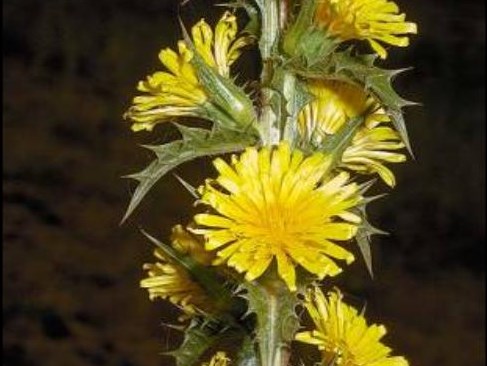Created by: Elizabeth D. Brusati
Created on: Thursday, Jan 28th, 2016
Created on: Thursday, Jan 28th, 2016
Yes or No:
Yes
Points:
1
Confidence Level:
Very High
Answer / Justification:
Besides California, naturalized in Alabama, Pennsylvania, New York, Australia (New South Wales, Victoria), Portugal, Canary Islands, Libya, Argentina, Chile.
Reference(s):
Yes or No:
Yes
Points:
2
Confidence Level:
Very High
Answer / Justification:
Naturalized in 4 California counties. Other areas similar to California are Portugal and the Canary Islands.
Reference(s):
Yes or No:
Yes
Points:
2
Confidence Level:
Very High
Answer / Justification:
Listed as a noxious weed in Victoria, Australia, where it invades grazing lands and "neglected areas". Considered a problem in Argentina and Chile.
Reference(s):
Yes or No:
No
Points:
0
Confidence Level:
Medium
Answer / Justification:
Listed as a noxious weed in Victoria, Australia. However, the locations where it is present in Victoria do not match California. Locations on GBIF from Australia are not a good match to California. There is only one location from Chile so I do not know how widespread it is or whether the locations match California.
Reference(s):
Yes or No:
Yes
Points:
1
Confidence Level:
High
Answer / Justification:
Scolymus maculatus is a listed noxious weed in New South Wales (Moree Plains Council Area), in a section of NSW that matches California. Dense patches become impenetrable to livestock.
Reference(s):
Yes or No:
Yes
Points:
2
Confidence Level:
High
Answer / Justification:
The native range is northern Africa (Morocco, Algeria, Tunisia), western Asia, and southern and eastern Europe. Besides California, naturalized in Alabama, Pennsylvania, New York, Australia (New South Wales, Victoria), Portugal, Canary Islands, Libya, Argentina, Chile. Many of these areas match California. GBIF map = http://www.gbif.org/species/5403742
Reference(s):
Yes or No:
Yes
Points:
1
Confidence Level:
High
Answer / Justification:
Forms dense infestations in Australia.
Reference(s):
Yes or No:
No
Points:
0
Confidence Level:
High
Answer / Justification:
No mention of this.
Reference(s):
Yes or No:
Yes
Points:
1
Confidence Level:
High
Answer / Justification:
Taproot and young shoots are edible to humans. Weed of grazing lands in Victoria, Australia. Not eaten by livestock because of the spines. Livestock avoid grazing close to plants. Answering yes because of impacts on livestock.
Reference(s):
Yes or No:
Yes
Points:
1
Confidence Level:
Very High
Answer / Justification:
Dense infestations become almost impenetrable to grazing animals in Australia.
Reference(s):
Yes or No:
No
Points:
0
Confidence Level:
High
Answer / Justification:
No mention of this.
Reference(s):
Yes or No:
No
Points:
0
Confidence Level:
High
Answer / Justification:
No mention of this.
Reference(s):
Yes or No:
Yes
Points:
1
Confidence Level:
Very High
Answer / Justification:
Reproduces by seed.
Reference(s):
Yes or No:
Points:
Confidence Level:
Very Low
Answer / Justification:
No information
Reference(s):
Yes or No:
Yes
Points:
1
Confidence Level:
Medium
Answer / Justification:
Flowers in late spring and summer and seeds germinate in autumn, winter, and spring.
Reference(s):
Yes or No:
Yes
Points:
1
Confidence Level:
Very High
Answer / Justification:
Yes, can be a biennial.
Reference(s):
Yes or No:
Points:
0
Confidence Level:
Very Low
Answer / Justification:
Flowers are formed in late spring and summer. Unclear how long seeds are produced.
Reference(s):
Yes or No:
Yes
Points:
1
Confidence Level:
Very High
Answer / Justification:
Spiny heads can be caught in wool (and therefore spread by sheep).
Reference(s):
Yes or No:
Yes
Points:
1
Confidence Level:
Very High
Answer / Justification:
Wind is important for dispersal. The plant breaks off at the ground and is blown long distances. Seeds also transported by water.
Reference(s):
Yes or No:
Yes
Points:
1
Confidence Level:
Very High
Answer / Justification:
Spiny heads are caught in agricultural produce. Some spread by agricultural equipment.
Reference(s):
Reviewed by Gina Darin, Ca Dept of Water Resources and Steve Schoenig, CA Dept of Fish and Wildlife and CA Dept of Food and Agriculture (retired)
- < 13 : accept (low risk of invasiveness)
- 13 - 15 : evaluate further
- > 15 : reject (high risk of invasiveness)
PRE Score:
17
Number of questions answered:
18
Screener Confidence (%):
87.8
Organization:
Evaluation visibility:
Public - accessible to all site users

